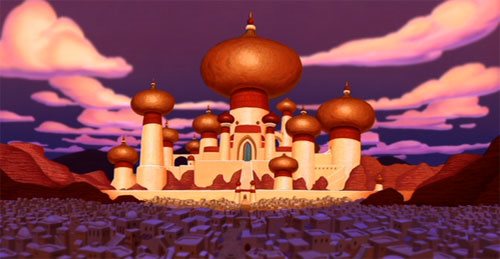For 84 years now, Walt Disney Animation Studios has been in
the castle-building business. Whether it's that golden castle-in-the-clouds
that we glimpse at the very end of "Snow White and the Seven Dwarfs
"
…

Copyright
Disney Enterprises, Inc. All rights reserved
… or that shiny undersea abode that King Triton resides in
…

Copyright
Disney Enterprises, Inc. All rights reserved
… the artists & designers at WDAS certainly have a
knack for creating memorable domiciles for royals. Be they kindly sultan …

Copyright
Disney Enterprises, Inc. All rights reserved
… or mistress of all evil.
Copyright
Disney Enterprises, Inc. All rights reserved
Which brings us now to Disney "Frozen." Since the
storyline of this big-screen comedy-adventure was inspired by Hans Christian
Andersen's "The Snow Queen" … Well, one of this film's main characters is
Elsa, a beautiful young woman who has the ability to magically conjure up ice
& snow out of thin air.
Copyright
Disney Enterprises, Inc. All rights reserved
"When you first meet Elsa in this movie, she's just a
little girl. So we wanted Elsa's magic at this point in the picture to be very
child-like and whimsical. So the simple snowflake shapes that she conjures up
reflect her age and her innocence," explained Marlon West, co-Effects
Supervisor on "Frozen." "But later on in this movie, when Elsa
finally lets go and really starts owning her magic, we wanted the ice &
snow that she conjures up to get across the idea that Elsa has now grown up and
become this beautiful, elegant, confident and powerful young woman."
But how would the artists at WDAS visually underscore Elsa's
new-found power and confidence? By having Disney's newest princess create her
own castle. Have Elsa use her magical abilities to manipulate ice & snow to
craft an elegant new home for herself out in the frozen wilderness.
(L to R) Lisa Keene, assistant Art Director; Mike Giamo, Art Director; Brittany Lee;
Visual Development Artist and yours truly. Copyright Disney
Enterprises, Inc. All rights reserved
But what exactly should Elsa's ice palace look like? Mike
Giaimo — Art Director of "Frozen" — admits that he and his design
team genuinely struggled to get a handle to get on this aspect of the film.
"We tried all of these magical castles, creating all of
these snow-packed interiors of what we thought Elsa's ideal home might look
like and we then showed them all to John Lasseter. And he then looked at us
like we were crazy," Giamo explained. "John said 'You're overlooking
the obvious choice here. Elsa's conjures up ice & snow, right? Well, have
you ever taken a close look at a snowflake? It's this simple, elegant,
six-sided shape. So why not make a giant snowflake the foundation of Elsa's
Palace and then turn it into a six-sided structure?' The solution was staring us right in the face
and we didn't even realize it. It took John to point it out to us."
Please note the giant
snowflake shape that's imbedded in the ice floor that Elsa is
standing on.
Copyright Disney Enterprises, Inc. All rights reserved
But Lasseter didn't just want the look of this elegant ice
palace to be influenced by snowflakes. John also suggested that the way that
snowflakes actually form in nature could then be reflected in the way that Elsa
conjures up her castle.
"Snowflakes are these tiny little ice crystals that
form in mid-air. And when there are changes in temperature and humidity, these
snowflakes start growing in a pattern that's known as branching and
plating," said Dale Mayeda, Co-Effects Supervisor on Disney
"Frozen." "When we did a pitch to John Lasseter early on about
the science behind Elsa's magic, he just loved the idea of how a snowflake
forms, how it branches & plates. And he said 'You know, when Elsa builds
her ice palace, it would be so amazing if — every step of the way as this
castle forms out of thin air — it's just branching & plating, branching
& plating all along the way."
Please note that the
decorative fountain to Anna's right also echoes the over-arching
snowflake
motif of Elsa's ice palace. Copyright Disney Enterprises, Inc.
All rights
reserved
"And we just loved that idea. That the epic & grand
way that this ice palace magically forms would then echo the way that a
snowflake really forms at the microscopic level. Which is why we ended up
carrying this design conceit all the way through this sequence in the
film," Mayeda continued. "After Elsa stamps her foot and that giant
snowflake on the ground forms, her ice palace then magically grows up around
her by branching & plating. And right from the beginning all the way
through to the last chandelier forming, this magical structure keeps on branching
& plating."
Mind you, committing to this design conceit did come at a
price. "For that one single shot in which Elsa builds her palace, 50
people worked on the technology required to execute that shot," said
Jennifer Lee, co-director of Disney "Frozen." "And that shot is
so complex that just one frame took 30 hours to render. That's a perfect
example of how much the 'Frozen' production team has put into this movie. And
it really shows. The finished film is just breathtaking."
Copyright
Disney Enterprises, Inc. All rights reserved
And just so you know: John Lasseter's love of the look & science behind snowflakes not only influenced the look of Elsa's ice palace, it
also had an impact on this character's costume design. Don't believe me? Then
check out Elsa's long, elegant, white lace cape.
Copyright Disney
Enterprises, Inc. All rights reserved
Yep. That's a snowflake too. So it seems like John's flaky
idea eventually became a pretty smart design motif for much of Disney
"Frozen," don't you think?
Your thoughts?
